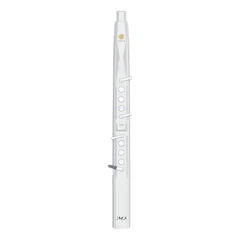Ten Tips for Beginners Learning Digital Saxophone
If you're a beginner embarking on the journey of learning a digital saxophone, also known as an Electronic Wind Instrument (EWI), here are ten valuable tips to help you make the most of your learning experience.
1. Choose the Right Instrument
The first step is to select a digital saxophone that suits your needs and budget. Consider factors such as build quality, sound quality, and ease of use. Look for an instrument with responsive keys and a comfortable mouthpiece. Some digital saxophones come with additional features like built-in effects and MIDI connectivity, which can enhance your playing experience. Do your research and read reviews to find an instrument that will be a good fit for you as a beginner.
2. Get Familiar with the Basics
Before you start playing, take some time to familiarize yourself with the different parts of the digital saxophone. Learn about the keys, buttons, and controls. Understand how to hold the instrument correctly and how to position your mouth on the mouthpiece. Familiarize yourself with the instrument's settings and functions, such as volume control, tone selection, and effects. This will help you feel more comfortable and confident when you start playing.
3. Start with Simple Exercises
Begin your learning journey with simple exercises to develop your finger dexterity and breath control. Practice playing single notes and scales slowly and evenly. Focus on producing a clear and consistent sound. Use a metronome to help you keep a steady tempo. As you progress, gradually increase the complexity of the exercises by adding more notes and different rhythms.
4. Learn Proper Breath Control
Breath control is essential for playing any wind instrument, and the digital saxophone is no exception. Practice taking deep breaths and exhaling smoothly and steadily. Learn to control the flow of air through the instrument to produce different volumes and tones. Experiment with different breathing techniques to find what works best for you. You can also practice breathing exercises outside of playing to improve your lung capacity and control.
5. Listen and Imitate
Listen to professional musicians playing the digital saxophone or other wind instruments. Pay attention to their technique, tone, and expression. Try to imitate what you hear by playing along with recordings or watching videos. This can help you develop your ear and improve your own playing. You can also listen to different musical genres to expand your musical vocabulary and inspiration.
6. Take Lessons or Join a Class
Consider taking lessons from a qualified instructor or joining a class for beginners. A teacher can provide personalized guidance and feedback, helping you progress faster and avoid common mistakes. They can also introduce you to different playing techniques and musical styles. In a class setting, you can interact with other beginners and learn from each other's experiences.
7. Practice Regularly
Consistency is key when learning any instrument. Set aside regular practice time each day or week. Even short practice sessions can be beneficial as long as they are focused and productive. Make a practice schedule and stick to it as much as possible. As you progress, you can gradually increase the length and intensity of your practice sessions.
8. Experiment with Different Sounds and Effects
Digital saxophones often come with a variety of sounds and effects. Experiment with these features to find new ways to express yourself musically. Try different tone settings, add effects like reverb or delay, and explore different combinations of sounds. Don't be afraid to be creative and have fun with the instrument's capabilities.
9. Record Yourself and Listen Back
Recording your practice sessions and performances can be a valuable learning tool. Listen back to your playing and identify areas where you need improvement. Pay attention to your tone, intonation, rhythm, and expression. You can also compare your recordings to professional musicians to see where you can make adjustments. Recording yourself can also help you track your progress over time.
10. Stay Motivated and Have Fun
Learning a new instrument can be challenging, but it should also be enjoyable. Set achievable goals for yourself and celebrate your progress along the way. Find music that you love and play it on your digital saxophone. Join a band or ensemble to collaborate with other musicians and have fun making music together. Remember why you started learning the instrument in the first place and keep your passion alive.
In conclusion, learning a digital saxophone as a beginner requires patience, dedication, and practice. By following these ten tips, you can set yourself up for success and enjoy the rewarding journey of mastering this unique instrument. Whether you're playing for fun or aspiring to become a professional musician, the digital saxophone offers endless possibilities for musical expression and creativity.
SUNRISE MELODY M1 Electronic Wind Instrument
. Revisit the passion and dreams of youth
. M1 electric clarinet wind instrument -- The good news for beginners
. Rich and diverse timbres
. Powerful functions and easy operation
. Perfect after-sales service



